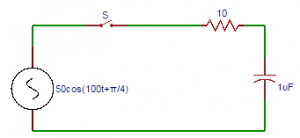This set of Network Theory online test focuses on “Sinusoidal Response of an R-C Circuit”.
1. In the sinusoidal response of R-C circuit, the complementary function of the solution of i is?
a) ic = ce-t/RC
b) ic = cet/RC
c) ic = ce-t/RC
d) ic = cet/RC
View Answer
Explanation: From the R-c circuit, we get the characteristic equation as (D+1/RC)i=-Vω/R sin(ωt+θ). The complementary function of the solution i is ic = ce-t/RC.
2. The particular current obtained from the solution of i in the sinusoidal response of R-C circuit is?
a) ip = V/√(R2+(1/ωC)2) cos(ωt+θ+tan-1(1/ωRC))
b) ip = -V/√(R2+(1/ωC)2) cos(ωt+θ-tan-1(1/ωRC))
c) ip = V/√(R2+(1/ωC)2) cos(ωt+θ-tan-1(1/ωRC))
d) ip = -V/√(R2+(1/ωC)2) cos(ωt+θ+tan-1(1/ωRC))
View Answer
Explanation: The characteristic equation consists of two parts, viz. complementary function and particular integral. The particular integral is ip = V/√(R2+(1/ωC)2) cos(ωt+θ+tan-1(1/ωRC)).
3. The value of ‘c’ in complementary function of ‘i’ is?
a) c = V/R cosθ+V/√(R2+(1/(ωC))2) cos(θ+tan-1(1/ωRC))
b) c = V/R cosθ+V/√(R2+(1/(ωC))2) cos(θ-tan-1(1/ωRC))
c) c = V/R cosθ-V/√(R2+(1/(ωC))2) cos(θ-tan-1(1/ωRC))
d) c = V/R cosθ-V/√(R2+(1/(ωC))2) cos(θ+tan-1(1/ωRC))
View Answer
Explanation: Since the capacitor does not allow sudden changes in voltages, at t = 0, i = V/R cosθ. So, c = V/R cosθ-V/√(R2+(1/(ωC))2) cos(θ+tan-1(1/ωRC)).
4. The complete solution of the current in the sinusoidal response of R-C circuit is?
a) i = e-t/RC[V/R cosθ+V/√(R2+(1/(ωC))2) cos(θ+tan-1(1/ωRC))+V/√(R2+(1/ωC)2) cos(ωt+θ+tan-1(1/ωRC)]
b) i = e-t/RC[V/R cosθ-V/√(R2+(1/ωC)2) cos(θ+tan-1(1/ωRC))-V/√(R2+(1/ωC)2) cos(ωt+θ+tan-1(1/ωRC)]
c) i = e-t/RC[V/R cosθ+V/√(R2+(1/ωC)2) cos(θ+tan-1(1/ωRC))-V/√(R2+(1/ωC)2) cos(ωt+θ+tan-1(1/ωRC)]
d) i = e-t/RC[V/R cosθ-V/√(R2+(1/(ωC))2) cos(θ+tan-1(1/ωRC))+V/√(R2+(1/ωC)2) cos(ωt+θ+tan-1(1/ωRC)]
View Answer
Explanation: The complete solution for the current becomes i = e-t/RC[V/R cosθ-V/√(R2+(1/(ωC))2) cos(θ+tan-1(1/ωRC))+V/√(R2+(1/ωC)2) cos(ωt+θ+tan-1(1/ωRC)).
5. In the circuit shown below, the switch is closed at t = 0, applied voltage is v (t) = 50cos (102t+π/4), resistance R = 10Ω and capacitance C = 1µF. The complementary function of the solution of ‘i’ is?

a) ic = c exp (-t/10-10)
b) ic = c exp(-t/1010)
c) ic = c exp (-t/10-5)
d) ic = c exp (-t/105)
View Answer
Explanation: By applying Kirchhoff’s voltage law to the circuit, we have
(D+1/10-5) )i=-500sin(1000t+π/4). The complementary function is ic = c exp (-t/10-5).
6. In the circuit shown below, the switch is closed at t = 0, applied voltage is v (t) = 50cos (102t+π/4), resistance R = 10Ω and capacitance C = 1µF. The particular integral of the solution of ‘ip’ is?

a) ip = (4.99×10-3) cos(100t+π/4-89.94o)
b) ip = (4.99×10-3) cos(100t-π/4-89.94o)
c) ip = (4.99×10-3) cos(100t-π/4+89.94o)
d) ip = (4.99×10-3) cos(100t+π/4+89.94o)
View Answer
Explanation: Assuming particular integral as ip = A cos (ωt + θ) + B sin (ωt + θ)
we get ip = V/√(R2+(1/ωC)2) cos(ωt+θ-tan-1(1/ωRC))
where ω = 1000 rad/sec, θ = π/4, C = 1µF, R = 10Ω. On substituting, we get ip = (4.99×10-3) cos(100t+π/4+89.94o).
7. In the circuit shown below, the switch is closed at t = 0, applied voltage is v (t) = 50cos (102t+π/4), resistance R = 10Ω and capacitance C = 1µF. The current flowing in the circuit at t = 0 is?

a) 1.53
b) 2.53
c) 3.53
d) 4.53
View Answer
Explanation: At t = 0 that is initially current flowing through the circuit is i = V/R cosθ = (50/10)cos(π/4) = 3.53A.
8. In the circuit shown below, the switch is closed at t = 0, applied voltage is v (t) = 50cos (102t+π/4), resistance R = 10Ω and capacitance C = 1µF. The complete solution of ‘i’ is?

a) i = c exp (-t/10-5) – (4.99×10-3) cos(100t+π/2+89.94o)
b) i = c exp (-t/10-5) + (4.99×10-3) cos(100t+π/2+89.94o)
c) i = -c exp(-t/10-5) + (4.99×10-3) cos(100t+π/2+89.94o)
d) i = -c exp(-t/10-5) – (4.99×10-3) cos(100t+π/2+89.94o)
View Answer
Explanation: The complete solution for the current is the sum of the complementary function and the particular integral. The complete solution for the current becomes i = c exp (-t/10-5) + (4.99×10-3) cos(100t+π/2+89.94o).
9. In the circuit shown below, the switch is closed at t = 0, applied voltage is v (t) = 50cos (102t+π/4), resistance R = 10Ω and capacitance C = 1µF. The value of c in the complementary function of ‘i’ is?

a) c = (3.53-4.99×10-3) cos(π/4+89.94o)
b) c = (3.53+4.99×10-3) cos(π/4+89.94o)
c) c = (3.53+4.99×10-3) cos(π/4-89.94o)
d) c = (3.53-4.99×10-3) cos(π/4-89.94o)
View Answer
Explanation: At t = 0, the current flowing through the circuit is 3.53A. So, c = (3.53-4.99×10-3) cos(π/4+89.94o).
10. In the circuit shown below, the switch is closed at t = 0, applied voltage is v (t) = 50cos (102t+π/4), resistance R = 10Ω and capacitance C = 1µF. The complete solution of ‘i’ is?

a) i = [(3.53-4.99×10-3)cos(π/4+89.94o)] exp(-t/0.00001)+4.99×10-3) cos(100t+π/2+89.94o)
b) i = [(3.53+4.99×10-3)cos(π/4+89.94o)] exp(-t/0.00001)+4.99×10-3) cos(100t+π/2+89.94o)
c) i = [(3.53+4.99×10-3)cos(π/4+89.94o)] exp(-t/0.00001)-4.99×10-3) cos(100t+π/2+89.94o)
d) i = [(3.53-4.99×10-3)cos(π/4+89.94o)] exp(-t/0.00001)-4.99×10-3) cos(100t+π/2+89.94o)
View Answer
Explanation: The complete solution for the current is the sum of the complementary function and the particular integral. So, i = [(3.53-4.99×10-3)cos(π/4+89.94o)] exp(-t/0.00001)+4.99×10-3) cos(100t+π/2+89.94o).
Sanfoundry Global Education & Learning Series – Network Theory.
To practice all areas of Network Theory for online tests, here is complete set of 1000+ Multiple Choice Questions and Answers.
If you find a mistake in question / option / answer, kindly take a screenshot and email to [email protected]
